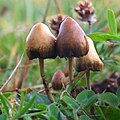Search results
Appearance
There is a page named "JWH-250" on Wikipedia
- JWH-091)The Δ8 isomer is also known as a synthetic cannabinoid under the code name JWH-091. It's unconfirmed whether or not Δ8-THCP is found naturally in cannabis...8 KB (700 words) - 21:49, 29 March 2025
- JWH-197 JWH-198 JWH-199 JWH-200 JWH-203 JWH-205 JWH-210 JWH-210 JWH-213 JWH-220 JWH-229 JWH-234 JWH-249 JWH-250 JWH-251 JWH-253 JWH-258 JWH-300 JWH-302...94 KB (10,286 words) - 13:13, 6 April 2025
- JWH-197 JWH-198 JWH-199 JWH-200 JWH-203 JWH-205 JWH-210 JWH-210 JWH-213 JWH-220 JWH-229 JWH-234 JWH-249 JWH-250 JWH-251 JWH-253 JWH-258 JWH-300 JWH-302...38 KB (4,317 words) - 14:09, 3 April 2025
- JWH-197 JWH-198 JWH-199 JWH-200 JWH-203 JWH-205 JWH-210 JWH-210 JWH-213 JWH-220 JWH-229 JWH-234 JWH-249 JWH-250 JWH-251 JWH-253 JWH-258 JWH-300 JWH-302...5 KB (458 words) - 05:16, 24 March 2025
- analogue of JWH-250 with the 1-pentyl group replaced by 1-(2-cyclohexylethyl), and can be expected to be less potent than JWH-250 (cf. JWH-007 and its...3 KB (197 words) - 16:39, 11 January 2025
- JWH-197 JWH-198 JWH-199 JWH-200 JWH-203 JWH-205 JWH-210 JWH-210 JWH-213 JWH-220 JWH-229 JWH-234 JWH-249 JWH-250 JWH-251 JWH-253 JWH-258 JWH-300 JWH-302...44 KB (4,529 words) - 17:08, 22 March 2025
FUB-AMB Isopropylbenzylamine JWH-018 JWH-071 JWH-072 JWH-073 JWH-081 JWH-098 JWH-122 JWH-210 JWH-250 JWH-251 JWH-252 JWH-253 Levomethamphetamine MAM-2201...
26 KB (1,722 words) - 19:38, 28 February 2025
(JWH-200) 6250 1-pentyl-3-(2-methoxyphenylacetyl)indole (JWH-250) 7081 1-pentyl-3-[1-(4-methoxynaphthoyl)]indole (JWH-081) 7122...
40 KB (1,596 words) - 01:13, 13 November 2024
JWH-073, a synthetic cannabinoid, is an analgesic chemical from the naphthoylindole family that acts as a full agonist at both the CB1 and CB2 cannabinoid...
12 KB (1,009 words) - 16:06, 24 November 2024
JWH-197 JWH-198 JWH-199 JWH-200 JWH-203 JWH-205 JWH-210 JWH-210 JWH-213 JWH-220 JWH-229 JWH-234 JWH-249 JWH-250 JWH-251 JWH-253 JWH-258 JWH-300 JWH-302...
33 KB (3,463 words) - 04:41, 15 March 2025
JWH-197 JWH-198 JWH-199 JWH-200 JWH-203 JWH-205 JWH-210 JWH-210 JWH-213 JWH-220 JWH-229 JWH-234 JWH-249 JWH-250 JWH-251 JWH-253 JWH-258 JWH-300 JWH-302...
57 KB (5,710 words) - 00:13, 5 April 2025
visuospatial praxis and psychomotor speed". Psychopharmacology. 100 (2): 243–250. doi:10.1007/bf02244414. PMID 2305013. S2CID 24645744. Lisboa SF, Vila-Verde...
60 KB (5,246 words) - 16:31, 17 March 2025
JWH-210 is an analgesic chemical from the naphthoylindole family, which acts as a potent cannabinoid agonist at both the CB1 and CB2 receptors, with Ki...
6 KB (500 words) - 16:07, 24 November 2024
metabolite of THC Delta-8-THC, one of the isomers of THC HU-210, WIN 55,212-2, JWH-133, synthetic cannabinoid agonists (neocannabinoids) Hashish List of investigational...
61 KB (5,565 words) - 20:02, 24 March 2025
JWH-197 JWH-198 JWH-199 JWH-200 JWH-203 JWH-205 JWH-210 JWH-210 JWH-213 JWH-220 JWH-229 JWH-234 JWH-249 JWH-250 JWH-251 JWH-253 JWH-258 JWH-300 JWH-302...
67 KB (6,912 words) - 23:56, 3 April 2025
JWH-197 JWH-198 JWH-199 JWH-200 JWH-203 JWH-205 JWH-210 JWH-210 JWH-213 JWH-220 JWH-229 JWH-234 JWH-249 JWH-250 JWH-251 JWH-253 JWH-258 JWH-300 JWH-302...
33 KB (2,892 words) - 17:49, 17 March 2025
JWH-197 JWH-198 JWH-199 JWH-200 JWH-203 JWH-205 JWH-210 JWH-210 JWH-213 JWH-220 JWH-229 JWH-234 JWH-249 JWH-250 JWH-251 JWH-253 JWH-258 JWH-300 JWH-302...
42 KB (4,701 words) - 19:31, 7 April 2025
- Moore of Alabama. J.L.M. Curry of Alabama. J.A. Stallworth of Alabama. J.W.H. Underwood of Georgia. L.J. Gartrell of Georgia. James Jackson of Georgia
- broadcaster; WW2 (Nil yet identified) - Comment: Several contemporaneous JWHs - Electoral Rolls: Nil yet identified Hart, Norman Victor [1,455] - 1908(Qld)-1998(Qld)














